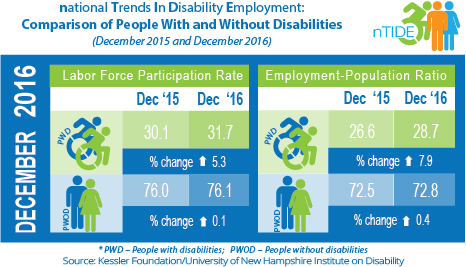nTIDE Jobs Report: Record Gains in Employment for People With Disabilities
 Durham, NH –The trend extended through the year’s end, making this the longest run of employment gains for Americans with disabilities since the Great Recession, according to today’s National Trends in Disability Employment – Monthly Update (nTIDE), issued by Kessler Foundation and University of New Hampshire’s Institute on Disability (UNH-IOD). Because of renewed emphasis on transitioning people with disabilities to the workplace, a growing number of innovative programs are providing comprehensive preparatory services for students with disabilities.
Durham, NH –The trend extended through the year’s end, making this the longest run of employment gains for Americans with disabilities since the Great Recession, according to today’s National Trends in Disability Employment – Monthly Update (nTIDE), issued by Kessler Foundation and University of New Hampshire’s Institute on Disability (UNH-IOD). Because of renewed emphasis on transitioning people with disabilities to the workplace, a growing number of innovative programs are providing comprehensive preparatory services for students with disabilities.
In the Bureau of Labor Statistics (BLS) Jobs Report released Friday, January 6, the employment-to-population ratio for working-age people with disabilities increased from 26.6 percent in December 2015 to 28.7 percent in December 2016 (up 7.9 percent; 2.1 percentage points). For working-age people without disabilities, the employment-to-population ratio increased slightly from 72.5 percent in December 2015 to 72.8 percent in December 2016 (up 0.4 percent; 0.3 percentage points). The employment-to-population ratio, a key indicator, reflects the percentage of people who are working relative to the total population (the number of people working divided by the number of people in the total population multiplied by 100).
“For the ninth consecutive month, we see improvement in the employment-to-population ratio for people with disabilities; the longest stretch ever seen since the BLS started publishing disability employment statistics in October 2008,” noted John O’Neill, PhD, director of employment and disability research at Kessler Foundation. “These improvements in the employment situation for people with disabilities in 2016 were better than the gains we saw last year. Let’s hope that this trend continues and we are able to reach pre-recession employment levels in 2017.”
The labor force participation rate for working-age people with disabilities increased from 30.1 percent in December 2015 to 31.7 percent in December 2016 (up 5.3 percent; 1.6 percentage points). For working-age people without disabilities, the labor force participation rate very slightly increased from 76 percent in December 2015 to 76.1 percent in December 2016 (up 0.1 percent; 0.1 percentage points).
“This is indeed another pretty good month and a really good run.” said Andrew Houtenville, PhD, associate professor of economics at UNH. “In addition, I can’t wait to see the seasonally adjusted trend, which we expect to release this spring. Stay tuned for the 2017 nTIDE Year in Review.
At Florida Atlantic University (FAU), a summer residential program offers people with disabilities the opportunity to explore careers and independent living. The program, which is called SOAR (Summer Opportunity for Adult Readiness) is sponsored by the nonprofit Autism After 21 with funding from Kessler Foundation. Adults age 18 to 25 spend 12 days living in a dorm with a college student mentor; high school students ages 16-17 have the option of a 5-day residential program.
During 2016, 14 SOAR students received a curriculum based on the Kessler College to Career (C2C) program during the 12-day session, including morning classroom sessions and afternoons with soft skills training. Three of these participants are now in college, one is employed, and five are in job training programs.
“SOAR is clearly helping people overcome obstacles to transitioning to the workplace,” reported Elaine E. Katz, MS, CCC-SLP, senior VP of grants and communications at Kessler Foundation. “We’re pleased to see that FAU, in partnership with Stand Among Friends and PolicyWorks, is building on the successes of this C2C program by introducing a 16-week soft skills course on Saturdays, to supplement the SOAR summer program. This approach may serve as a model for other university-based programs.”
In December 2016, among workers ages 16-64, the 4,531,000 workers with disabilities represented 3.2 percent of the total 142,977,000 workers in the U.S.
The next nTIDE will be issued on Friday, February 3, 2017.
Join our nTIDE Lunch & Learn series, starting today, January 6 at 12:00pm EST. This live broadcast, hosted via Zoom Webinar, will offer attendees Q&A on the latest nTIDE findings, provide news and updates from the field, as well as host-invited panelists to discuss current disability-related findings and events. Jane Boone, employment consultant and Jobs by 21 Partnership Project manager, joins Drs. Houtenville and O’Neill, Michael Murray, COO of AAPD, and Michael Gamel-McCormick, PhD, of the Association of University Centers on Disabilities (AUCD), to discuss today’s findings as well as employment for people with intellectual and developmental disabilities. You can join live, or watch the recordings at: www.ResearchonDisability.org/nTIDE.
NOTE: The statistics in the National Trends in Disability Employment Update are based on Bureau of Labor Statistics numbers, but are NOT identical. They’ve been customized by the University of New Hampshire to efficiently combine the statistics for men and women of working age (16 to 64). NTIDE is funded, in part, by grants from the National Institute on Disability, Independent Living and Rehabilitation Research (NIDILRR) (9ORT5022-02-00 & 90RT5017) and Kessler Foundation.